IJWR – vol.1 2018 – NEWS – Controversial comments – Miscellanea
NEWS
ITALIAN JOURNAL WOODPIGEON RESEARCH – IJWR – 2018 IJWR @2018
Vol.1 –
“ La MIGRAZIONE AUTUNNALE del COLOMBACCIO ( Columba palumbus ) in ITALIA”
“Autumn migration of Woodpigeons in Italy “ 
Edited by Club Italiano del Colombaccio – published by ARACNE EDITRICE – Roma
Is incoming next months 2018 as a BOOK and E-BOOK on-line
The Monography is articulated by 23 Chapters in 295 pages .
The Preface is by Prof.Dr.Przemyslaw Busse – “Emeritus” University of Gdansk – Polonia . Bird Migration Research Foundation –
INDEX of the incoming Book
– Introduzione – Introduction
– Il Colombaccio – The Woodpigeon
– Le foreste in Europa – Le Agricolture intensive – Forests & Agricolture
– Status corporeo dei Colombacci migratori – Status of the body
– Le Origini – The Origins
– Elementi di Orografia – Orography
– Le Rotte Migratorie – Le destinazioni – Fly-ways and destinations
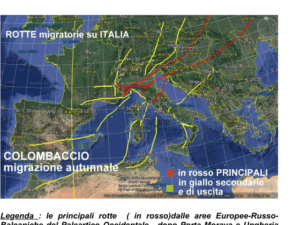
– Modalità del volo di migrazione sull’Italia – Flights’ dynamics
– Picchi migratori ed Involi di massa – Picks and mass take-off
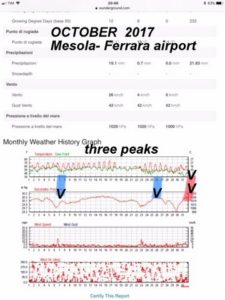
– La raccolta dei dati di osservazione della migrazione – Collecting data
– Metodologie di Ricerca : i Forum – Forums
– Progetto Colombaccio 1997-2007 : documentazione testimoniale –Testimonial 1997-2007
– Progetto Colombaccio Italia – 2007-2015
– Le migrazioni autunnali 2014 e ” 2015 – 2016″ in Italia – 3 years reports
– La migrazione 2017 – Migration 2017
– Le Isobare – Isobars
– Eventi straordinari della migrazione – Special events
– La Luna e la migrazione – Moon & migrations
– Le migrazioni notturne – Night’s migration
– Variazioni morfologiche : colombacci codoni,roscioli,topacchi – Special morphologies
– La Ricerca – The Research
– Indicazioni e proposte di ricerche – Proposals of researches
– Conclusioni – Conclusion
BIBLIOGRAFIA ( Letteratura e Web ) – References
NEWS from “ Woodpigeons’ literature & Web “
Paper accepted – incoming publishing on 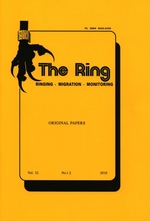
THE RING journal https://www.degruyter.com/view/j/ring#
The general pattern of seasonal DYNAMICS OF THE autumn migration of the Wood Pigeon Columba palumbus in Italy
Enrico Cavina , Rinaldo Bucchi and Przemysław Busse
Cavina E., Bucchi R.,Busse P. 2018. The general pattern of seasonal dynamics of the autumn migration of the Wood Pigeon Columba palumbus in Italy. Ring 40: XX-XX.
- Cavina, Club Italiano del Colombaccio, ; R.Bucchi , Club Italiano del Comobaccio , Italy; P. Busse (corresponding author), Bird Migration Research Foundation, Przebendowo 3, 84-210 Choczewo, Poland, e-mail: busse@wbwp-fund.eu
……………….OMISSIS …………………….
„ We have here five or six groups of pigeons passing Italy in different parts of the autumn and the time of the passage incuding a few peak days is quite well stable between years. Yearly peaks in different waves, as well as the waves themself are not regularly of the same relative volumes, but this is normal that different groups have own number size and migration dynamics. „
MONITORAGGIO SELETTIVO MIGRAZIONE – MSM –
SELECTIVE MONITORING of the MIGRATION – MSM
Rinaldo Bucchi – Club Italiano Colombaccio
Special paper in press CIC Meeting – Poggibonsi Italy – June 2018
The selected analyis of 2017 migration has been performed over 7 selected Regional areas by the observation of 27 hunters . Many details are exposed by graphics and tables .Full published results will be presented at the annual Meeting of the Italian Club in Poggibonsi next June . Critical analysis MSM will be integrated with the results of MCL and “Progetto Colombaccio Italia” as expected , just now after few months after . the end of the autumn migration –Other possible integration will be performed with the results of the “ Study of the wintering woodpigeons in Italy 2017-2018 “ as by Denis Bianchi work in progress .
Synthetic report on Selective Migration Monitoring (M.M.S)
The new research carried out by Club Italiano del Colombaccio (the Italian Association of traditional woodpigeon hunters) was developed by gathering data from some strategic migration monitoring points located along the main migratory routes of central-northern Italy.

The selectivity of the measurements and of the following elaboration has allowed Club Italiano del Colombaccio to develop a research that highlights the endemic phenomena of the monitored territories and compares the different migration events. The result was an overview that well represents the post-breeding migration of the woodpigeons along the main entrance routes of the “Italian” migration.
The forms prepared for the surveys, which had to be filled in by all hunters who voluntarily took part in the monitoring process, included various “parameters” which made it possible to estimate, for each hunting and monitoring station:
– the calendar of the migration during the end of September, October and beginning of November;
– the average daily / seasonal amount of wood pigeons and flocks spotted;
– the composition of the flocks (classification of flocks);
– the quantity of preys collected, as well as their age (age classification of preys);
– the main hours of migration during the monitoring period;
– the way in which the samples were spread during the hunting season;
– the incidence rates of traditional hunting on migrating flocks of woodpigeons;
– the incidence rates of traditional hunting on the three age groups in which woodpigeons are divided for the purposes of this research;
This first report will be followed by others: the constancy of the monitoring process carried out over time and in the same places by the same volunteers will give further added value to this research. This study entirely relied on the goodwill and on the curiosity of the traditional woodpigeon hunters who joined the Club Italiano del Colombaccio: their exciting desire to learn and understand more about the woodpigeons’ migration shows their mature sensitivity and responsible vision of the hunt, a practice that is completely sustainable if exercised in a compatible manner with the demographic dynamics of the species.
The data gathered through this research has been used to develop charts which can be easily understood: the first goal has been reached, however it is now essential to tackle the enormous difficulty that hunters face in communicating their role to the community and in particular to non-hunters. The hunt is often identified with a thunderous and intrusive rifle shot: this is a narrow-minded outlook and those who spend hours, days, seasons year after year on top of a tree, waiting to spot a flock in migration are well aware of this.
If this research manages to change some critical and radical positions towards hunters, we’ll be able to claim that it truly reached its main goal.
 Total Numbers Italy
Total Numbers Italy 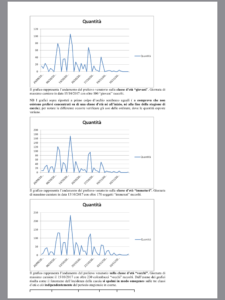 Total very young,young,adult
Total very young,young,adult
Paper incoming
lRiserva Naturale Bosco della Mesola e lo svernamento del colombaccio nel bosco.
Woodpigeons wintering in Mesola forest – work in progress Winter 2017-18
Denis Bianchi – Club Italiano del Colombaccio
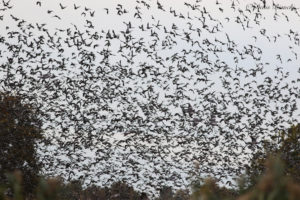
PRELIMINARY REPORT
After a detailed presentation of the habitat and woodpigeons behaviour in the Mesola forest , the Author ( working with a team of hunters CIC ) reports detailed results during 6 investigations on the spots ( 21 Nov.,5-15-16 28 Dec. 2017 , 7 Jan.2018 ) . Preliminary conclusions say that after a very important arrival of woodpigeons from North East Balkans ( mostly Istria ) and Central Europe during migratory season ( mostly October ) by thousands and thousands birds , and impressive growing up of woodpigeons stayin’g in Stop-over , at the same way impressive reduction happens in November and following months . It seems to depend more on the hunting noise than the missing agricultural energy reserves. It seems necessary to underline a strong contrast between the real real investigations (some thousands remain wintering) and the investigations passed in the years 80-90 (one hundred thousand wintering) when the agriculture was mainly corn and soy with immense stubble and residues of corn and soy that they remained on site almost all winter, which no longer exists today because of an agriculture composed mainly of vegetables.
Paper incoming
RESEARCH on PARASITES of WOODPIGEONS migrated in Central Italy during Autumn 2017
Izabella Rzad | PhD | University of Szczecin, Szczecin

The Researcher Izabella RZAD – of the Bird Migration Research Foundation – University of Szczecin .POLONIA, has concluded February 25th the first part of the Parasitological study on the viscera of 121 woodpigeons collected in Italy – thanks to the exclusive collaboration of the Italian Club Colombaccio of Emilia, Romagna, Tuscany, Umbria, Marche – during the last migratory season. Dr. RZAD expressed the most heartfelt thanks to everyone for such an important collaboration and participation. After an initial phase of study – on site in Fabriano (Marche) – about 20% of the examined birds were positive in the presence of various types of Parasites, fundamentally not harmful to humans. The further typological identification of the Parasites will be completed in the Laboratories of the University of Szczecin in Poland for a definitive drafting of the Work for International Ornithological Literature.
Before this detailed work, it was possible to compile TWO summary tables of the first survey, from which a very important and surprising data seems to emerge: the presence of Parasites is enormously greater in the Pigeons collected in the incoming Entrance Area of Migration, that not in the subsequent transit areas. Despite the “variables” of cataloging error of the examined birds (location, timing, etc.): this difference in incidence could be explained very theoretically.
As it has been found in research on migrations of Passeriforms, it seems that the sea crossings, although limited in time, determine adverse conditions to the life of the Parasites first acquired, so after the stop-over the incidence of Parasites decreases dramatically.
It could therefore be the case of the woodpigeons disembarked and captured in the first part of the Migration (Emilia Romagna Marche), and then find themselves sverminati continuing the Migration. However, this is only a hypothesis that could be explored in Autumn 2018, even with differentiated collections on Migrants and Overwinterers.
Attachment – TABLES
TOTAL Woodpigeons Birds with Parasites% of Birds Intensity MEAN -From-To
CESTODA 24 19.5% 3 1 – 6
DIGENEA 4 3.2% 2.7 1 – 5
NEMATODA 3 2.4% 1.3 1 – 2
TOTAL 28 22.8% 2.
Total prevalence 28/123 = 22.8%
INTESTINAL HELMINTHS in 123 Woodpigeons (Columba palumbus) – ITALY Migration autumn 2017
REGIONS BIRDS collected – With Parasites – Numbers of Birds
V V V Cestoda Digenea Nematoda
MARCHE 28 10 35.7% 9 1 2
ROMAGNA 38 11 28.9% 8 3 1
TUSCANY 39 6 15,3% 6 – –
UMBRIA 18 1 5.5% 1 – –
TOTAL 123 28 – 24 4 3
With this initiative, the Italian Club of Colombaccio probably makes the first Parasitological Research on the Woodpigeons migrating to Italy.
Controversial items – Research opinions ( short texts -open space)


Ornitologia “accademica” vs. Ornitologia “venatoria”
di Enrico Cavina – www.labeccacciascientifica.it –
È indubbio che le conoscenze ornitologiche – per alcune specie cacciabili – sono cresciute enormemente in questi ultimi due decenni grazie alla crescita culturale del mondo venatorio che ha affrontato e sviluppato molti aspetti anche fenologici in termini propriamente scientifici .
Infatti solo l’attenta osservazione sul campo di fenomeni legati alla biologia , all’ adattamento ambientale , all’ecologia sensitiva ed alla ecologia migratoria , ha permesso l’acquisizione di conoscenze nuove – nonché l’approfondimento con metodi d’indagine innovativi – circa i comportamenti di molti uccelli sia sedentari sia migratori.
Ciò è stato possibile principalmente grazie all’impegno di osservazione sul campo , sviluppato con continuità e perseveranza ,da parte di Cacciatori . Questa continuità di attenzione non è certo stata sempre tale per l’impegno di studio degli Ornitologi “ufficiali” pur presenti con analisi rigorosamente scientifiche se pur sporadiche , come facilmente si può rilevare se si effettuano ricerche sul Web ( es. Google) .
Da molte parti – anche Istituzionali e Accademiche – si accenna a denunciare che le nuove generazioni di Ornitologi troppo spesso si impegnano in Ricerche c.d. ” facili” che consentono pubblicazioni scientifiche brevi o ripetute su argomenti d’interesse minimale rispetto a più vaste necessità di Ricerca anche sperimentale su argomenti e problematiche di più vasto interesse scientifico e di ecologia ambientale . In termini di irriverente analisi possiamo forse dire che è più facile fare uno studio sulla nidificazione della ” Silvia ortiensis” che non sulla migrazione di milioni di “Columba palumbus” : si trova così facile via di pubblicazione e relativo “impact factor” utile ad acquisire titoli per Curriculum e carriera istituzionale . Ripetendo il giochino su piccole ricerche , su facili osservazioni ornitologiche , su vacanze insulari sulle vie migratorie dei Passeriformi, si acquisiscono facili titoli : sembra anche di poter dire di un Emerito Professore Europeo di Ornitologia che confidenzialmente ci definiva questi giovani Ricercatori come ” ratti famelici” delle Scienze Biologiche . Certamente non è tutto così nel più vasto mondo della Ornitologia ufficiale , ma questa tendenza alla “faciloneria” della Ricerca , è preoccupante , anche perchè troppo spesso legata ai c.d. animalisti che sfruttano queste ricerche , molto spesso approssimative e prive di serie verifiche , per sviluppare politiche repressive sul mondo della Caccia . Ne fa fede un recente Lavoro Italiano nel quale – sulla base delle 500 beccacce sequestrate all’Aeroporto di Rimini alcuni anni fa’ – si cerca di evidenziare la pericolosità di mangiare beccacce per intossicazione da piombo utilizzando arzigogolate elucubrazioni statistiche in dispregio dell’ “evidence based” evidenza che non sono mai stati denunciati quadri clinici pertinenti a questa ipotesi chiaramente per noi redatta per scopi anti-caccia .
Viene da domandarsi anche se è tutto vero quello che viene pubblicato su Riviste Ufficiali di Ornitologia ed Ecologia per articoli che sono dichiaratamente selezionati e che presentano sofisticate analisi statistiche . Purtroppo a monte di Lavori estremamente seri , si ritrovano Lavori che nel contesto di queste sofisticate analisi includono veri “falsi” difficilmente rilevabili nel contesto di girandole di numeri e formule statistiche . Ne fa fede quanto abbiamo potuto rilevare in https://www.researchgate.net/publication/290086786_Autumn_migration_or_Common_Wood_Pigeon_Columba_palumbus_in_the_Jura_mountains_in_relation_to_weather_High_variation_in_daily_migratory_intensity dove nella Tabella a pag. 207 vengono riportati datati i picchi migratori di Colombacci in migrazione nello Jura con specifiche numeriche dal 1998 al 2007 . Abbiamo voluto verificare direttamente le condizioni meteo che sono analizzate nel Lavoro , risalendo ai parametri meteo di dettaglio : ebbene controllando sugli Archivi di Weather History emerge che le acquisizioni di 7 anni su 10 , sono da ritenersi “false” sia nell’analisi sia nella documentazione .
Altro esempio di inconsistente presentazioni di dati ci viene da “Ardeola 58(2),2011,315-323” dove l’oggetto del Lavoro – verosimilmente finalizzato all’acquisizione di fondi di Ricerca – è il census delle popolazioni di Colombacci nell’area Baltica : ebbene in una girandola di dati percentuali ed elaborazioni statistiche e tabelle basate sulla densità di presenze per ettaro di area boschiva , non si riesce a leggere un solo , anche uno solo, numero crudo indicativo per capire quanti sono i nidificanti nell’area .
Per altro verso molte Associazioni Venatorie si sono impegnate a modulare la crescita culturale e scientifica dei Cacciatori in vari settori di Caccia specialistica , offrendo innumerevoli dati di osservazione naturalistica , quali nessuna Istituzione scientifica è oggi in grado di raccogliere , se non appunto in collaborazione con Associazioni venatorie .
Ciò è valso e vale sia per la Beccaccia sia per il Colombaccio e per specie Acquatiche .
Se ci riferiamo alla Beccaccia , una “summa” di questi contributi scientifici derivati quasi esclusivamente dal mondo venatorio , può essere facilmente verificata scorrendo gli Aggiornamenti on-line redatti in 10 anni da www.labeccacciascientifica.it e tra questi fa spicco l’Aggiornamento 2014 dedicato alla bella Monografia ” Le beccacce di Vormsi” espressione di un lungo percorso di ricerca scientifica sul campo , promosso dal Club Italiano della Beccaccia ed inizialmente coordinato da Silvio Spanò , e tuttora attivo anche nella sua difficile autonomia di sovvenzione economica .
Le attività delle Associazioni beccacciaie in Italia sono ben note , continuativamente presenti nello sforzo di coniugare attività venatorie e Ricerca scientifica , quali ben risultano anche dalla presenza di una Federazione Europea . In Europa anche nei più recenti costosi impegni di Ricerca Satellitare , tutto dipende dall’intenso coinvolgimento dei Cacciatori .
Recentemente ci siamo occupati di studiare alcuni aspetti molto particolari inerenti la migrazione di Beccaccia e Colombaccio , cercando di coinvolgere e discutere con Ornitologi “ufficiali” ed Istituzionali . Le acquisizioni ricavate da una ricerca retroattiva riguardante il rapporto tra fattori abiotici ed involi migratori di massa o comunque -per la Beccaccia- involi di grandi concentrazioni migratorie quali ben conosciuti dai cacciatori di Beccacce, in qualche modo sono state pubblicate on-line . Sono acquisizioni di un lampante interesse di stimolo per la Ricerca tesa ad approfondire le conoscenze specifiche ( Aggiornamento Agosto 2014 ” La beccaccia e la Pressione Atmosferica” di www.labeccacciascientifica.it– dettagli bibliografici ) . Dovrebbe essere questo un interesse da sviluppare nel vasto campo della anatomo-fisio-ecologia dei sensi degli uccelli migratori : un richiamo ed uno stimolo per Ricerca pura e Ricerca applicata .
I dati raccolti in questa citata ricerca retroattiva sono stati analizzati statisticamente come numeri crudi ed in buona parte rifiutati da vari Ornitologi . Così rifacendoci ad un particolare Journal Internazionale on-line gestito da Editor di prestigio , i dati sono stati pubblicati ( www.scienceheresy.com ) ed ora risultano ormai da un anno ai primi posti di varie ricerche su Google con parole chiave tipo “birds migration research” e similari .
Questa – pur sempre strana – esperienza va a dimostrare che se l’Ornitologia ufficiale si rifiuta di pubblicare ricerche prodotte al di fuori della stantia liturgica ortodossia accademica , è pur sempre possibile affermare i risultati derivati da esperienze di Cacciatori .
Dobbiamo altresì segnalare che perseverando con immensa fatica nella ricerca di collaborazioni con l’Ornitologia Accademica è sempre possibile trovare risposte costruttive . Nel settore di studio della migrazione del Colombaccio ( www.scienceheresy/ornithology.com ) i dati raccolti dalla ventennale esperienza di Progetto Colombaccio del Club Italiano del Colombaccio si sono coagulati in un più ampio progetto di Testo Monografico ” La Migrazione autunnale del Colombaccio in Italia ” ( Editing in progress) redatto con la collaborazione di alcuni iscritti del Club Italiano del Colombaccio e con la raccolta di dati rilevati in 20 anni da oltre 150 Osservatori cacciatori di ogni parte d’Italia .Questo Testo può avvalersi della prefazione qualificata di insigne Ornitologo del Nord Europa , il quale ha definito l’immenso lavoro di raccolta di dati come un “ponte” tra cacciatori ed Ornitologi , ed allo stesso tempo ha affermato che così grande raccolta di dati lascia ” attoniti di fronte alla pochezza delle ricerche condotte da Ornitologi ” . Questo materiale è stato poi elaborato da Ricercatori del Bird Migration Research Foundation (https://www.linkedin.com/company/bird-migration-research-foundation ) con la definizione di numerosi grafici di sofisticata analisi statistica su un campione di 10 anni relazionato a 9 Regioni Italiane interessate dai flussi migratori .
Questa insperata collaborazione con l ‘ Ornitologia ufficiale ha comunque indotto ad aggiornare un Capitolo di questa Monografia sul Colombaccio con un commento critico e possibilmente esaustivo che possiamo qui riportare .
< Comunque – a prescindere dalla validità scientifica dell’analisi ed elaborazione statistica sovraesposta – non è fuori luogo a nostro avviso esprimere anche in questa sede alcune considerazioni generaliste . Non per niente alcuni risultati delle nostre analisi retroattive sui dati raccolti in Progetto Colombaccio in oltre 20 anni , sono stati pubblicati on-line dal Journal ” Science Heresy ” , rivista internazionale digitale basata su alcuni principi di “policy” quali qui espressi
” In recent times the physical sciences have become orthodox, authoritarian, sterile and dysfunctional, much like the mediaeval church. This is the outcome of the rigid institutionalization of science and incestuous peer review. Scientists guard their patch jealously ……..omissis
Furthermore much that passes as “science” is, in reality, a form of mathematical idealism whereby a theory only …… omissis ”
Esiste quindi un contrasto idealistico tra una “forma di idealismo matematico” versus una Scienza basata su evidenze ( “evidence based”) anche di numeri crudi .
Molte delle evidenze riportate documentativamente nel testo della presente Monografia dedicata allo studio della Migrazione autunnale del Colombaccio in Italia , sono evidenze solidamente iscritte nella tradizione venatoria di molti osservatori-rilevatori-cacciatori – essi stessi depositari di ben più antiche tradizioni e conoscenze – che ben conoscono “empiricamente” le fluttuazioni migratorie stagionali che si sviluppano stagionalmente sulla penisola Italiana e queste conoscenze collimano oggi con i risultati delle elaborazioni statistiche , pur sofisticate, che ricercano conferme “idealmente matematiche” a quanto di fatto è già presente nella conoscenza della Migrazione in innumerevoli appostamenti di caccia , diffusi sul territorio Italiano . Insomma – volendo azzardare un commento “irriverente” – potremmo dire che gli Scienziati di oggi ” hanno scoperto l’acqua fresca o calda che sia” .
Volendo comunque attenerci ad una valutazione davvero scientifica , dobbiamo riconoscere che la suesposta analisi statistica su 10 anni di Progetto Colombaccio , indica la presenza di 6 (sei) gruppi di popolazioni distinte di Colombacci che migrano in Italia in autunno con varie ondate migratorie . E questo è indubbiamente un fatto “nuovo” per le nostre conoscenze , anche se solo lo sviluppo di ulteriori Ricerche ( vedi radioisotopi e monitoraggio satellitare ) potrà in futuro darne conferma . >
Concludendo ,abbiamo ritenuto opportuno riportare integralmente questa Nota critica che ci è sembrata riassumere le problematiche del rapporto tra Ornitologia Accademica ed Ornitologia Venatoria . Anche con questo articolo vorremmo sempre più indicare ai Cacciatori la necessità di perseverare e migliorare un continuo qualificato impegno nel raccogliere dati naturalistici utili alla Ricerca Scientifica .
ENGLISH text ( Google translation)
“Academic” ornithology vs. “Hunters’ ornithology”
by Enrico Cavina – www.labeccacciascientifica.it –
There is no doubt that the ornithological knowledge – for some game species – has grown enormously in the last two decades thanks to the cultural growth of the hunting world that has faced and developed many aspects, including phenological ones, in scientific terms.
In fact, only the careful observation in the field of phenomena related to biology, environmental adaptation, sensitive ecology and migration ecology, has allowed the acquisition of new knowledge – as well as the deepening with innovative methods of investigation – about the behavior of many birds both sedentary and migratory.
This was possible mainly thanks to the Hunters’ commitment to field observation, developed with continuity and perseverance. This continuity of attention has certainly not always been such due to the commitment of the study of “official” Ornithologists, even though they are present with rigorously scientific analyzes, even if sporadic, as can easily be detected if research is carried out on the Web (eg Google).
In many parts – including Institutional and Academic – there are indications that the new generations of Ornithologists too often engage in Researches c.d. “easy” that allow short or repeated scientific publications on topics of minimal interest compared to broader research needs, including experimental research on topics and issues of wider scientific interest and environmental ecology. In terms of irreverent analysis we can perhaps say that it is easier to do a study on the nesting of “Silvia ortiensis” than on the migration of millions of “Columba palumbus”: it is so easy to publish and relative “impact factor” useful to acquire titles for Curriculum and institutional careers. Repeating the game on small research, on easy ornithological observations, on island holidays on the migratory routes of Passerines , you can acquire easy titles: it seems to be able to say of a Emeritus Professor of Ornithology who confidently defined these young researchers as “ravenous rats” of Biological Sciences. Certainly it is not all that in the wider world of official Ornithology, but this tendency towards the “easy approach ” of the Research, is worrying, also because too often linked to the c.d. animalists who exploit these research, very often approximate and without serious verification, to develop repressive policies on the world of hunting. This is a recent Italian Work in which – based on the 500 woodcocks seized at the airport of Rimini a few years ago – they try to highlight the danger of eating woodcock for lead poisoning using convoluted statistical speculations in contempt of “evidence based” “evidence that no clinical pictures have ever been reported relevant to this hypothesis clearly written for us for anti-hunting purposes.
One wonders if it is all true what is published in Official Journals of Ornithology and Ecology for articles that are openly selected and that present sophisticated statistical analysis. Unfortunately, upstream of extremely serious works, we find works that, in the context of these sophisticated analyzes, include real “fakes” that are difficult to detect in the context of the turning of numbers and statistical formulas. This is what we can find in https://www.researchgate.net/publication/290086786_Autumn_migration_or_Common_Wood_Pigeon_Columba_palumbus_in_the_Jura_mountains_in_relation_to_weather_High_variation_in_daily_migratory_intensity where in the table on p. 207 are dated the migratory peaks of Woodpigeons migrating in the Jura with numerical specifications from 1998 to 2007. We wanted to check directly the weather conditions that are analyzed in the Work, going back to the weather parameters of detail: well checking on the Archives of Weather History shows that the acquisitions of 7 years out of 10 are to be considered “false” both in the analysis and in the documentation .
Another example of inconsistent data presentations comes from “Ardeola 58 (2), 2011.315-323” where the object of the Work – probably aimed at acquiring Research funds – is the census of the Woodpigeons ‘ populations in the area Baltica: well in a swirl of percentage data and statistical processing and tables based on the density of presences per hectare of wooded area, you can not read a single, even one, raw number indicative to understand how many are nesting in the area.
On the other hand, many Hunters’ Associations have undertaken to modulate the cultural and scientific growth of the Hunters in various specialized hunting sectors, offering innumerable naturalistic observation data ( “ CITIZEN SCIENCE” ) , such as no scientific Institutions .
SCIENTIFIC JOURNALS against SCIENTIFIC LITURGY
It could be intended out of the rules , something as anrchism or true scientific terrorism, but sometimes the courage to publish journal as message against the excesses of traditional ortodoxy -at present times- can obtain good results by the justice of the Web.
It is the case of SCIENCE HERESY today supported by the policy of “CITIZEN SCIENCE” and its philosophy .
http://www.scienceheresy.com/

| ” In recent times the physical sciences have become orthodox, authoritarian, sterile and dysfunctional, much like the mediaeval church. This is the outcome of the rigid institutionalization of science and incestuous peer review. Scientists guard their patch jealously and regard any truly new idea as a threat to the established order. Discovery has given way to territoriality and there is little cross-fertilization between disciplines.
Furthermore much that passes as “science” is, in reality, a form of mathematical idealism whereby a theory only has to be internally consistent in order to be accepted as fact. Mathematicians have a cavalier disregard for experiment and observation. We provide a platform and a readily accessible archive for evidence-based science that is either new, ignored or actively suppressed by “orthodox” science. Science Heresy is subdivided into the following on-line journals: |
||||||||||||||||||||
|
Science Heresy is a Journal of empirical science ”
It’s really extraordinary that some papers published on this anomalous Journal after few months result at first line on the citations collected by Google as new “global” impact factor search motor on the Web : the Justice seems automatic.
The idea and managing of John Reid ( Tanzania Australia ) have been winners.
http://www.scienceheresy.com/scienceheresyarchive/2011_03/Editorial11_03a.pdf
On this way and idea , the challenge of a new Ornithological Journal on-line starteed in march 2018 : Italian Journal Woodpigeon Research .
John Reid is a member of the Editorial Board .
News real-time 
Spring migration
6th March 2018 a very early migration started through the Appennine mountains in Central Italy ( Romagna) : a lot of big flocks directed to Adriatic sea and Balkans .8th march late afternoon confirmed big flocks ( sizes more 1000 birds ) migrating over Mugello ( Tuscany) directed East Nord East .
13 March – Mass spring migration’s movements also today on the Central Italy’s Appenine Mountains ( Romagna ) .
During last 3 hours of the morning of today Saturday 24th March 2018, a “river” of woodpigeons by continous big flocks ( also by sizes of thousands) from West is crossing Central North Appenine mountains ( Romagna region) directed to Adriatic coasts and Balkans .The persons who have recorded this phenomenon have said that never it happened in man’s memory